Civil unrest, epidemics, terrorism and natural disasters are increasing in many parts of the world. The infrastructures crumble and many basic sanitation services are lost. Health care becomes a challenge. How can we create a sustainable, functional solution without running water and electricity?

The idea of a micro-hospital in a container came to Rolof Mulder in 2010, whilst he was installing a medical unit near a hospital in West Africa. He called it Hospitainer; it is a medical unit equipped with operating tables, instruments, drugs, post-operating treatment areas, etc. After the earthquake that hit Haiti killing 10,000 people, Doctors Without Borders immediately contacted Rolof Mulder to ask him to come to their aid with his Hospitainer and using his first prototype, they were able to perform more than 2,000 operations over a period of ten months, saving thousands of lives.

In areas hit by disaster, explained Rolof Mulder, "the response must be fast. More than 80% of deaths caused by injuries, disease and complications can be reduced through use of the Hospitainer." Five years on and the Hospitainers used have seen more than 8,000 operations, with more than 50,000 people treated. The company has recently created Hospivessel, a floating island currently helping to save refugees trying to cross the Mediterranean, assisting 2,200 people in a single month.

